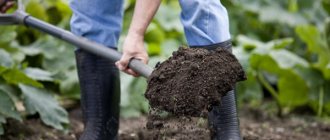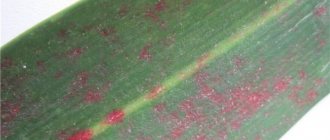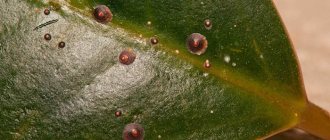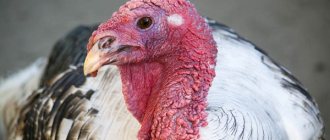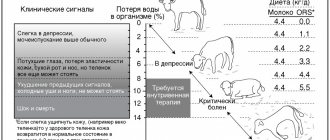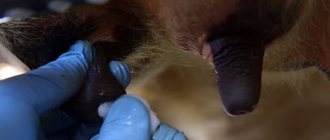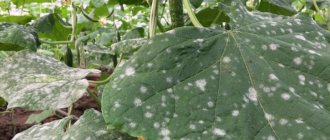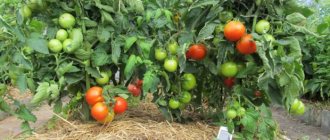Root rot in cucumbers in a greenhouse - causes
The causative agent of the disease is facultative parasites - fungi. They appear in the soil as a result of unfavorable growing conditions, thereby weakening the plant and facilitating the further proliferation of pathogens.
The appearance of fungal spores in the soil is facilitated by
- sharp daily temperature fluctuations;
- prolonged drop in air and soil temperatures;
- insufficient lighting;
- excessive watering, especially with cold water. With abundant watering, soil moisture increases, and there is less air in it.
The root system of cucumbers weakens and becomes vulnerable to phytopathogens. This is also caused by a high concentration of salts in the soil and drying out of the roots. The causative agents of the disease first settle in weak and dead areas, and then are mistaken for healthy plant tissue. In other words, it is easier for cucumbers to contract root rot than to avoid it.
The root is affected and, as a result, stops working normally. In the initial stage of the disease, when the sun comes out during the day, the leaf works as before, normally, moisture evaporates from the leaves. But the root cannot provide additional moisture, so the leaves droop and wilt due to lack of moisture.
At night, when evaporation from the leaves decreases, the plant has enough moisture. The leaves return to normal again, leaf turgor is restored. In the morning, having examined the leaves, you see that the leaves are in normal condition, and you calm down. Although the pathogenic process continues.
The next sunny weather everything repeats again. And this will happen day after day until the pathogen completely occupies the root system. It is at this stage that most of the leaves of the plant will be affected and they will begin to dry out.
Signs of defeat
White rot of cucumber
A sign of damage is a fluffy white coating over all parts of the plant (roots, lashes, leaves, fruits). The substances released by the pest fungus not only destroy plants, but also remain in the soil for a very long time. Over time, the affected plant tissues rot completely. It is difficult to fight this disease, but it is quite possible in the initial stages.
Gray rot of cucumber
Gray rot affects cucumbers mainly in protected soil. The lesion begins first with the lower aging leaves, then the pathogen spreads to the stem. Light brown dry spots form on the stem. The damage to the fruit begins with the stalk, then a gray spot appears, quickly covering the entire fruit, its surface becomes watery and covered with gray fluff, the so-called conidial sporulation.
Signs of root rot in cucumbers in a greenhouse (photo)
In the first stage of the disease, the leaf plate of the plant begins to wither, at first one or two, gradually the number of wilted leaves becomes more and more. The second stage is characterized by yellowing and drying of the foliage. Such signs can be noticed throughout the growing season, but more often an adult plant is damaged.
Look at the photo to see what the affected plants look like.
The disease primarily affects the root of the plant. When digging up the roots, you may notice that they are covered with brown or reddish-brown spots. The affected roots are not able to absorb moisture and nutrients from the soil, the plant does not receive them in the required quantity, and the plant begins to gradually die. During the second stage of the disease, the roots generally become rotten and darken.
The earlier the disease is affected, the greater the likelihood that the plant will die and not produce the desired harvest. And if the fruits do appear, they grow weak, crooked and underdeveloped.
Horse rot should not be confused with another disease of cucumbers, in which the leaves also wither - this is fusarium. In the first case, only the root is affected, which is not able to supply moisture to the above-ground part. In the second case, with Fusarium wilt, the root remains healthy, but the vessels in the lower part of the stem are affected and become sclerotic. The root in this part dries out, and the plant again does not receive the moisture and nutrients it needs. A peculiar constriction appears on the trunk, which may not be noticed at first.
Who is the causative agent of rot?
The cause of rotting cucumber roots is the work of many harmful microorganisms. The most common and dangerous among them are:
- Pythium debaryanum - this microorganism attacks the roots during germination, as a result of which cucumbers begin to rot at the root, the leaves and cotyledons turn yellow.
- P. ultimum is a fungal pathogen that affects 150 different plant species in addition to cucumbers. Spreads with the help of nematodes.
- P. aphanidermatum - affects more than 80 plant species, but causes the greatest damage to cucumbers, as well as soybeans and tomatoes. It multiplies in affected tissues during root molt.
How to revive cucumbers with root rot
Cucumbers can be returned to normal development and fruiting only in the initial stage of the disease. That is, when you notice 1-2 wilted leaves. To do this, add additional soil so that additional young roots appear on the stem.
If you pay attention to the lower part of the stem (about 3-4 cm from the surface of the ground), you will notice small small pimples. This is something other than the beginnings of roots. They cannot develop in the air, as they quickly dry out and die.
These root rudiments can be allowed to grow, just sprinkle them with soil. To do this, first, all the leaves are removed from the lower part of the stem, and the stem is carefully untied from the trellis. Carefully, so as not to break, lay the stem in a semicircle or tilted, and sprinkle it with fertile soil. If the soil is dry, water with warm water. In the case of a large stem, we tie it up again.
In 10-15 days, new roots will emerge from the tied part of the stem, which means a new root system has formed. In this case, the old rot will no longer interfere.
How to cure root rot in cucumbers
Seeing drooping cucumber leaves in a greenhouse, many gardeners think that the plant does not have enough water and rush to water the plant quickly. But in doing so, they make a big mistake. Before watering, you need to check whether the soil is moist and the condition of the roots. Move a little soil away from the roots and see their condition, and at the same time you will find out whether the soil is dry or wet. Inspect them carefully and check:
- Have the roots changed color to yellow or reddish-brown?
- Have they softened?
- Are there any cracks in the central root?
And also look to see if the leaf blades have turned yellow or drooped. If the answers to these questions are negative, the plant really does not have enough moisture and needs to be watered. If the answers are affirmative, it is necessary to urgently begin to treat the plant.
Previkur Energy
This is a systemic two-component fungicide. The active ingredients include propamocarb, which inhibits the growth of mycelium, and fosetyl, which prevents the germination of fungal spores. In addition, fosetyl is able to restore the plant’s defense reactions and stimulates the growth of the root system.
The drug is used strictly according to the instructions for the drug. To prepare a working solution, dilute 3 ml of the drug per 2 liters of water, or 15 ml per 10 liters of water. Working fluid consumption – 2 liters per 1 sq. m of soil. This method is suitable if the rot has not yet developed enough.
Remember that the fungicide is not compatible with fertilizers. With traditional treatment methods, the effect increases when mixed with contact fungicides. Previkur is added to a moist substrate so that its active substance easily penetrates the root system of the plant. The drug has unique stimulating capabilities; after treatment, seedlings are characterized by enhanced growth and development.
Treatments are carried out immediately after sowing seeds and planting seedlings in the ground. During the growing season, plants are treated every 2 weeks, pouring the solution under the root. When carrying out spraying treatment, it is better to do it in cloudy weather or in the evening, after sunset.
Glyocladin
Glyocladin is a biofungicide created to combat bacterial and fungal infections and is used for therapeutic and preventive purposes. The active substance is trichoderma, depending on the humidity of the air and soil, the effect of the drug lasts 4-7 days.
Using gliocladin, the soil microflora is improved in a short time, the growth of pathogenic microflora is suppressed, it does not persist in the plant for a long time, it is safe for humans, for insects and for the plants themselves, and is economical. Plants can be eaten immediately after using the drug.
If the cucumber vine already has ovaries, it is no longer possible to use chemical fungicides. If the disease has not gone too far (not many brown dried leaves), it is quite possible to cure an adult plant with the help of Glyocladin.
Glyocladin is used for watering or placing tablets under the root. It begins to act actively only in the upper layers of the soil, in which air access is provided, no deeper than 8 cm, with soil moisture of 60-80%, rapid development of hyphae occurs in the temperature range of 20-25 ° C, soil acidity pH from 4.5 to 6. At pH above 7, the growth of fungal mycelium is greatly inhibited. The drug is not used for foliar spraying.
The drug is available in tablet form. Read the instructions carefully before use and follow the rules for preparing and using the solution.
Trichocin
Trichocin is a biological fungicide, the active substance of Trichoderma. The drug is used for treatment of root and basal rot during the growing season. The rate of impact is 3-5 days from the moment the drug is applied to the soil.
Sold in powder form in 6 g bags. To prepare a solution, dilute 6 g (1 bag) in 10 liters of water, pour 100 ml of cucumbers at the root. The drug is compatible with fertilizers and growth stimulants, but it cannot be used simultaneously with other fungicides.
Fundazol
Fundazol is a chemical fungicide and is highly effective against fungal diseases. It is toxic and does not harm the plant, but an overdose of the drug can lead to unpleasant consequences in humans. Therefore, before use, be sure to read the instructions for use on the package.
The active ingredient, benomyl, works in a wide temperature range, which makes it possible to use the product for soil treatment from spring to autumn. When applied to a plant, the active substance quickly spreads throughout the cells, creating a protective barrier. When watered at the root, it is also quickly absorbed by the roots, quickly spreading throughout the plant.
The drug is not toxic to plants and soil. The drug is released in the form of a white or slightly yellowish color. For treatment, the drug is diluted according to the instructions, since each type of treatment has its own dose. Apply the preparation for spraying and water the soil.
Reasons for appearance
It is easier to foresee and prevent any disease than to get rid of it later. In order to prevent white rot from approaching your cucumbers, it is worth studying the reasons for its appearance.
What factors contribute to the emergence
It is very easy to introduce the disease to cucumbers: sclerotia can get to the crop with irrigation water, when adding fresh soil to the soil under the plantings, by using tools that were previously used to treat the infected areas. Another factor contributing to the appearance of sclerotia is wind: it can transport fungal spores over long distances. And for white rot to spread massively throughout all the bushes, just one spore is enough.
Processing cucumber bushes should be carried out carefully and carefully, trying not to damage the plants. After all, it is through cracks and mechanical damage that spores get inside.
Did you know? The spines on cucumbers are needed to remove excess moisture. Early in the morning, a drop of dew appears from each spine.
Conditions for the development of rot
Lightning-fast development of white rot occurs under the following conditions:
- High air humidity in a greenhouse. Experienced gardeners advise regularly ventilating the greenhouse and ensuring good ventilation. In open ground, the ideal period for the disease to infect bushes is prolonged rains.
- Low temperature. If greens grow in a greenhouse, the temperature should not fall below +20°C, and when grown in open ground, the ideal temperature is +20...+22°C.
- Using cold irrigation water, especially in hot weather. This creates ideal conditions for the germination of fungal spores.
- Thickened plantings that retain moisture prevent ventilation and warming of the soil.
- Neglect of timely pruning of bushes, which leads to their thickening.
- Oversowing greens with thickening crops (dill, parsley, salads).
Important! Even if there was only a small speck of white rot on the cucumber fruit, it is impossible to eat such a vegetable: it loses its edibility, acquiring a bitter taste, becomes soft and covered with mucus.
Treatment of root rot in cucumbers with phytosporin and copper sulfate
One of the most effective means of helping to cope with various fungal diseases in plants is Fitosporin. A systemic drug whose active ingredient is a live spore bacterium - Bacillus subtilis. The bacterium is capable of suppressing the proliferation of pathogens of fungal and bacterial infections. The effect of the drug spreads throughout the vascular system, affecting the plant at the cellular level.
Fitosporin is used for preventive and therapeutic purposes. In the fall, preparing the greenhouse for winter, the soil is treated for preventive purposes. For medicinal purposes, the drug is used by watering the working solution of the plant at the root. The action of spore bacteria begins instantly, immediately after treatment. Its waste products act on fungi and bacteria, suppressing their reproduction.
But in order for the result to be positive, it is necessary to take into account the mistakes that gardeners often make when using the drug. In the same article you will find detailed instructions on how to use Fitosporin.
To cultivate the soil in greenhouses, gardeners successfully use a solution of copper sulfate. You can disinfect the soil a week before planting seedlings in the greenhouse. To do this, dilute with a 3% solution (30 g of substance per 10 liters of water).
To save cucumbers from disease, water the plants with a solution prepared from 1 tsp. copper sulfate + 1 tsp. zinc sulfate + 1 tbsp. l. superphosphate. Water the bushes at the root at the rate of 5 liters of solution per 1 square meter. m. When preparing the solution, dissolve the components in a plastic container and warm water for better dissolution.
Prevention
To prevent the spread of root rot, treat the seeds before sowing. A convenient and affordable method of disinfection is etching in a solution of potassium permanganate. Many vegetable growers use the drug “Fitosporin-M” to disinfect seed material.
Advice!
Additionally, the soil intended for planting seeds for seedlings is disinfected. It is spilled with a strong solution of potassium permanganate or Fitosporin-M. Steaming the soil or freezing is also practiced.
Greenhouse care
May be interesting Recommendations for growing the hybrid cucumber “Mama's favorite f1” Features of using the drug Aktara to protect cucumbers from pests Varieties of cucumbers for open ground (Self-pollinating)
To prevent harmful fungi from accumulating in the soil and on the elements of the shelter structure, the greenhouse is treated every year in the fall after the harvest. Mandatory activities include:
- spraying the wooden parts of the greenhouse with a solution of copper sulfate;
- washing ferrous metal and galvanized parts with laundry soap;
- washing the glazing elements with a soapy solution, followed by rinsing with clean water from a hose;
- Thorough cleaning of all plant debris and other debris.
If during the growing season there were cases of plant infection in the greenhouse, the premises are disinfected using a sulfur bomb. Then in the spring, biological products are added to the soil to restore the microflora, since all beneficial microorganisms die during disinfection along with harmful ones.
Compliance with the planting pattern
Cucumbers are planted taking into account the rules of crop rotation. Constant planting in one place provokes the accumulation of pathogenic microorganisms in the soil and an outbreak of disease. Cucumbers are replanted in one area once every 3 years. When growing in greenhouses, the fertile soil layer is replaced every 2 years. To do this, use soil from areas where onions, garlic, herbs, cabbage, and potatoes grew.
Also, be sure to adhere to the planting scheme recommended for the crop variety. Placing plants too close leads to crowding, makes it difficult to detect signs of disease earlier and creates favorable conditions for the development of infections.
How to deal with root rot in cucumbers using folk remedies
When growing vegetables, many gardeners prefer simplicity and effective folk remedies. They are inexpensive and always on hand. Here are some of them.
- Baking soda . Dissolve 2 tbsp. l. soda in 10 liters of water, mix the solution and pour the cucumbers under the root. Before processing, pre-water the soil with warm water.
- Zelenka . And although brilliant green does not contain copper, many gardeners successfully use it in the treatment of root rot. For preventive purposes, dilute 1 drop of brilliant green per 10 liters of water, diluted according to the calculation. For treatment, dilute at the rate of 1 drop per 1 liter of water. The prepared solution is watered at the root of the plant, which is first loosened to a depth of no more than 0.5 cm.
- Serum . Whey is usually acidic, and in an acidic environment, fungal spores tend to develop less. To adjust the solution, add 9 liters of water and 40 drops of iodine to 1 liter of serum. Mix the solution thoroughly. The prepared solution is sprayed on plants and leaves on both sides, and the solution is also watered on cucumbers at the root.
Symptoms of cucumber infection
The first symptoms that your cucumbers are starting to rot appear after transplanting the crop into the ground or greenhouse.
- The cucumber stem turns brown and begins to rot.
- The leaves begin to yellow.
- Cracks form at the bottom of the central shoot.
- The roots become brown and soft.
- In the advanced stage of the disease, the ovaries begin to wither.
Rot progresses especially actively at low (below 16 °C) and high (from 27 °C) temperatures. If you find these signs in plants, you must immediately begin treatment, otherwise the cucumbers will die.
Eliminating the causes of root rot in cucumbers
To protect against fungal diseases, you must adhere to the following rules.
- Renew the soil before each season. If this is not possible, in the fall, when preparing the greenhouse for winter, or 1-2 weeks before planting seeds or seedlings in the greenhouse, treat the soil with Fitosporin;
- Water the plants only with warm water, make sure that the soil is not waterlogged;
- Loosen the ground under the cucumbers (but shallowly so as not to damage the roots);
- Avoid sudden changes in temperature in the greenhouse;
- Inspect the plants regularly; when the first signs of disease appear, begin treatment immediately;
- Remove a plant severely damaged by rot from the greenhouse immediately;
- Plant the varieties that are the most resistant to fungal diseases, F1 hybrids: Advance, Orlik, Benefit, Valdai, Maisky, Yarmorochny, Tsygan.
I wish you good harvests!
Conclusions and recommendations
Thus, timely detection of damage to cucumber crops by a fungus - PEST and the use of simple agrotechnical techniques (cleaning and destruction of plant residues, compliance with crop rotation and regime, introduction of resistant varieties) together with the use of biological products (seed dressing, soil disinfection) will help you easily overcome this " disease" and save the plants. And by preserving the plantings, you will not be left without a good harvest.
*Changes and additions were made on July 11, 2019.
